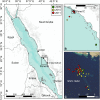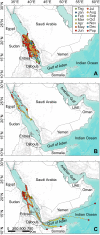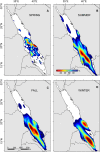Movement patterns of juvenile whale sharks tagged at an aggregation site in the Red Sea
- PMID: 25076407
- PMCID: PMC4116204
- DOI: 10.1371/journal.pone.0103536
Movement patterns of juvenile whale sharks tagged at an aggregation site in the Red Sea
Abstract
Conservation efforts aimed at the whale shark, Rhincodon typus, remain limited by a lack of basic information on most aspects of its ecology, including global population structure, population sizes and movement patterns. Here we report on the movements of 47 Red Sea whale sharks fitted with three types of satellite transmitting tags from 2009-2011. Most of these sharks were tagged at a single aggregation site near Al-Lith, on the central coast of the Saudi Arabian Red Sea. Individuals encountered at this site were all juveniles based on size estimates ranging from 2.5-7 m total length with a sex ratio of approximately 1∶1. All other known aggregation sites for juvenile whale sharks are dominated by males. Results from tagging efforts showed that most individuals remained in the southern Red Sea and that some sharks returned to the same location in subsequent years. Diving data were recorded by 37 tags, revealing frequent deep dives to at least 500 m and as deep as 1360 m. The unique temperature-depth profiles of the Red Sea confirmed that several whale sharks moved out of the Red Sea while tagged. The wide-ranging horizontal movements of these individuals highlight the need for multinational, cooperative efforts to conserve R. typus populations in the Red Sea and Indian Ocean.
Conflict of interest statement
Figures







References
-
- Colman JG (1997) A review of the biology and ecology of the whale shark. J Fish Biol 51: 1219–1234. - PubMed
-
- Stewart BS, Wilson SG (2005) Threatened Fishes of the World: Rhincodon typus (Smith 1828) (Rhincodontidae). Environ Biol Fishes 74: 184–185 10.1007/s10641-005-2229-1 - DOI
-
- Heyman WD, Graham RT, Kjerfve B, Johannes RE (2001) Whale sharks Rhincodon typus aggregate to feed on fish spawn in Belize. Mar Ecol Prog Ser 215: 275–282.
-
- Ramírez-Macías D, Meekan M, La Parra-Venegas D, Remolina-Suárez F, Trigo-Mendoza M, et al. (2012) Patterns in composition, abundance and scarring of whale sharks Rhincodon typus near Holbox Island, Mexico. J Fish Biol 80: 1401–1416. - PubMed
Publication types
MeSH terms
LinkOut - more resources
Full Text Sources
Other Literature Sources

